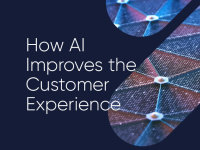AI strategies to boost customer engagement
AI gives brands the tools to anticipate needs, solve problems before they surface, and deliver meaningful experiences. Explore how to use AI to forge ...
Customer interactions don’t happen in a vacuum; your customers interact with your company through myriad channels and at many different stages throughout the buyer’s journey. While analytics for single-touchpoint, single-channel interactions provide valuable insights into the effectiveness of your messaging at that juncture, they fall short of painting the full picture.
Enter customer journey analytics: a solution that eliminates data silos and combines otherwise segmented data to empower marketers to improve the customer experience throughout the entire customer journey, from end to end. Here’s what you need to know about customer journey analytics, its benefits, and how it works.

Customer journey analytics typically refers to software that enables companies to manage the customer experience across all channels and touchpoints. According to G2 Crowd, customer journey analytics software “tracks, weaves together, and analyzes customer interactions across all channels so that businesses can react in real time and execute behavior-driven strategies.”
Today’s consumers engage with businesses through a growing number of channels, creating a complex web of customer touchpoints. Customer interactions at each of these touchpoints can have a significant impact on the overall customer experience. What’s more, experiences at various touchpoints can be influenced by previous interactions customers have had with your business. Having insight into not only the touchpoints through which customers engaged with your brand but also customer sentiment, behavior, and emotions is crucial for businesses to provide seamless, omnichannel customer experiences throughout the customer journey.
By aggregating structured and unstructured data from every customer touchpoint, customer journey analytics provides a comprehensive, end-to-end view of the journey your customers take from the first introduction to post-purchase experiences. Armed with these insights, organizations can make data-driven decisions about the next best action to achieve the desired outcome, whether that means making a sale, resolving a customer concern, or preventing customer churn.
Customer journey analytics is not the same as customer journey mapping. While customer journey mapping is the process of creating a visual map or representation of the touchpoints throughout the buyer’s journey, customer data analytics connects data from those touchpoints across all channels over time. That said, customer journey mapping is a valuable precursor to customer journey analytics.
Having end-to-end visibility into the touchpoints through which customers can engage with your organization and the likely path they’ll take throughout the customer journey provides valuable context to customer data.
Analyzing data from every customer touchpoint over time gives organizations insight into how certain customer behaviors influence business outcomes. This visibility can help businesses identify the best actions to take based on where the customer currently is along the customer journey, where they’re likely to go next, and your business objectives.
Customer journey analytics solutions are used to track and monitor customer behavior and satisfaction across multiple channels, from the first introduction to a brand or company throughout the entire relationship. Because the customer journey doesn’t end with the purchase, customer analytics solutions go past the point of purchase to monitor and analyze behavior through customer service interactions and beyond.
Traditionally, businesses relied on customer feedback tools such as customer satisfaction surveys to gauge how well the organization is meeting customers’ needs. When considered along with metrics such as customer churn, organizations can infer that declining customer satisfaction contributed to an increase in customer churn, but the insights end there. The business doesn’t have any information to indicate the specific customer behaviors leading up to customer churn or the interactions customers had with the business that resulted in declining customer satisfaction. In other words, businesses would know that their customers are less satisfied than they were before and some are leaving as a result, but they don’t know why—or what they can do to change those outcomes.
One hallmark of customer journey analytics is that it combines both quantitative and qualitative data. It allows companies to identify the customer journeys that have the biggest impact on specific business goals – such as increasing revenue or reducing customer churn – and making data-driven decisions designed to influence those outcomes. For instance, a company might identify a key set of touchpoints the majority of leads visit immediately prior to making a purchase, and then leverage this insight to better optimize interactions at those touchpoints to increase the percentage of leads that convert to customers. Alternatively, marketers could optimize the path to purchase by driving more leads to those key touchpoints.

Most businesses today understand the value of analytics solutions to provide insight into practically every business function, from marketing to customer support. The widespread adoption of business analytics has led to myriad analytics tools and solutions, which can be overwhelming for organizations trying to determine what type of analytics solution they need for their particular use case.
Customer journey analytics differs from other types of analytics solutions in that it aggregates data from a variety of touchpoints over time. Other analytics solutions, such as marketing analytics solutions, focus more on business outcomes like campaign performance without providing insight into the customer experience. Some inferences can be made from this data, such as increased conversion rates indicating that customers are largely satisfied. However, customer journey analytics goes beyond the surface to provide insight into what the customer experienced, their emotions and sentiment at each touchpoint throughout the journey and what interactions had the largest impact on customer behavior.
That’s not to say that marketing analytics and other types of analytics solutions aren’t useful and don’t have their place. But for organizations that want to eliminate data silos and delve deep into customer behavior, customer sentiment, and customer satisfaction at each and every interaction throughout the customer journey, customer journey analytics provides the end-to-end visibility businesses need to drive business performance.
By combining data about customer behavior with marketing metrics, companies gain a better understanding of customer needs and wants, as well as actionable insights that can inform decision-making.
What’s more, customer journey analytics enables companies to better forecast and predict customer behavior based on data gained through historical interactions and similar messaging at various touchpoints.
Customer journey analytics helps companies answer questions such as:
To get the most from customer journey analytics, follow these best practices.
CallMiner Visualize powered by Tableau® brings your speech analytics data story to life. Customize and compare graphical data to reveal insight to enable change. With an accessible workspace through CallMiner Analyze, easily create your visual narrative for all audiences in and beyond the contact center.